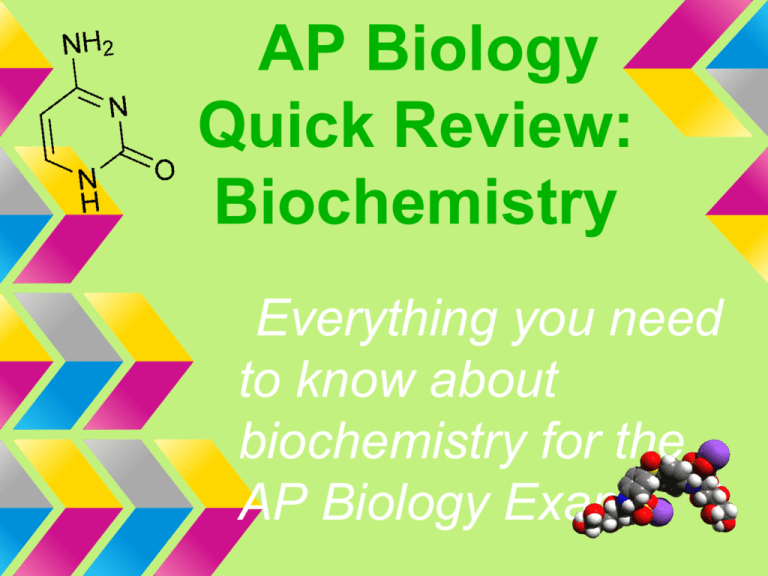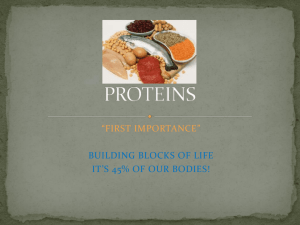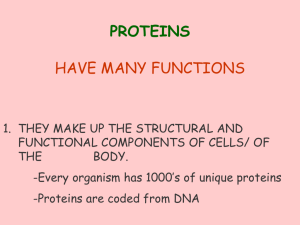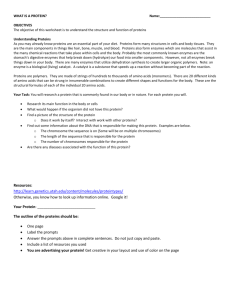File - Hi I am Enxhi Ferraj!
advertisement

AP Biology Quick Review: Biochemistry Everything you need to know about biochemistry for the AP Biology Exam! All About Water! - Water is the best example of a polar molecule (the oxygen is the more electronegative atom). - The properties of water allow life to sustain on earth: cohesion ("water to water" sticking), adhesion ("water to other" sticking), lower density as a solid, superb solvent, high specific heat, and high heat of vaporization. - Who can tell the importance of each property? Examples? - Most of water's properties result from hydrogen bonding, a weak attraction that occurs when an "electron" hungry atom (like oxygen) attracts hydrogen atom's electrons. Remember, this "bond" is extremely weak but essential for life. - Water is prevalent in the body and is an apt environment because the phospholipid bilayers of cell membranes spontaneously form in water (this could not occur without water. The Importance of Carbon - The study of molecules and compounds containing carbon is called "organic chemistry". - Carbon atoms are versatile building blocks because they have four valence electrons, allowing for four stable covalent bonds to be made. This is why carbon is so prevalent in major macromolecules in the body. - There are four types of carbon compounds that are covered on the exam: carbohydrates, lipids, proteins, and nucleic acids. - Carbon compounds are complex molecules that are assembled from smaller subunits (lipids are the exception because they are composed of long hydrocarbon chains as opposed to smaller monomers). - OFF WE GO! Carbohydrates - Carbs are usually synonymous with sugars - simple or complex - Composed of carbon, hydrogen, and oxygen atoms in a set empirical formula: (CH20)X; the "X" stands for number of carbons (so obviously the number of carbons in carbs is variable). - What are carbs used as? Structural components, sources of short-term energy storage, and raw materials. -Three types of carbs: monosaccharides, disaccharides, and polysaccharides. Who can tell the difference between them? - Sugars are build like any other macromolecule, by dehydration synthesis and broken down by hydrolysis. - Sugars cost LITTLE ENERGY to build and can easily release energy (short term energy storage remember!) - Energy storage polysaccharides: glycogen and starch (which one do plants use? Animals?) - When used as building materials for organisms, polysaccharides can be cellulose or chitin. Which organisms use which? -It is important to know that polysaccharides can be highly branched as well as linear. With that being said, why can't humans digest cellulose as expertly as some other organisms? Lipids - Of the organic compounds, Lipids are the ones known for long-term energy. They are composed of carbon, hydrogen, and oxygen but unlike carbohydrates they have long chains of hydrocarbons. -For the AP exam, it is vital to know these types of lipids: fats, phospholipids, and steroids. -What is the monomer of a lipid? Does anyone know? -A fat or triacylglycerol is a glycerol (3C alcohol) and three fatty acid tails. They are non-polar and hydrophobic and have 2x more energy storage than carbohydrates because energy can be stored in the hydrocarbons. Can anyone tell the difference between saturated and unsaturated fats? -Phospholipid is formed when combining a glycerol with 2 fatty acid tails and a phosphate group (head). Can someone tell us how phospholipids form a bilayer due to being hydrophobic and hydrophilic? Lipids (Not even done yet D: ) -A steroid is a type of lipid that always has 4 fused carbon rings and a functional group. Explain how a different structure here can have a different function for the steroid (refer to hormones as an example). -Cholesterol is found in animal cell membranes and is a precursor of all other steroids. Why is it important that cholesterol be found in the cellular membrane? -BIG IDEA: How does the structure of the phospholipid bilayer affect its function? (What characteristics does it have?). Nucleic Acids - These extremely complex molecules are the genetic materials for all living organisms. They come in two colors: DNA and RNA. - ALWAYS REMEMBER: DNA makes RNA makes PROTEINS. This will always come back to bite you in the... uh, gluteus maximus later on. - What are some differences between DNA and RNA? C'mon you know you know it! T-t-today Junyah! - The monomer of the nucleic acid is a nucleotide (NOT to be confused with a nucleoside). What constitutes a nucleotide? Well, a sugar, phosphate, and base of course! BUT that's not enough for the AP exam we're afraid. Who can be more specific? - The purine nucleotides are adenine and guanine and the pyrimidine nucleotides are cytosine and thymine (and uracil in RNA). - IMPORTANT CONCEPT: DNA replication is directional and based off a system of copying a template, where each newly synthesized strand acts as a template for the next copy. Proteins -YOUR INNER MANTRA: PROTEINS ARE EVERYWHERE AND DO EVERYTHING! -Proteins have many different jobs seeing as how there are so many different proteins due to changes in structure therefore changes in function. Some proteins are enzymes, some are structural proteins, some are used for cell communication etc. - The monomer of a protein is an amino acid. Amino acids are bonded together by peptide bonds and therefore they form a polypeptide chain! Proteins can be 1 or more polypeptide chains folded/bonded together. Makes sense now! -Amino acid structure involves a central carbon, amino group, carboxyl group, and an individual R group which does what again? How is this structure vs. function? (think polar perhaps?) and this affects how amino acids interact? -Proteins grow in a specific direction because DNA is directional and it sequences proteins.. N-terminus = NH2 end, C-Terminus = COOH end. (NCC= protein) - Proteins (Cont'd) 1. Primary Structure: correct order of amino acids in chain. A slight change in the correct order can affect the protein's future function. How does this apply to sickle cell anemia? 2. Secondary Structure: the "local folding" of the polypeptide. The local folding is caused by interactions between adjacent amino acids through the hydrogen bonds. This local folding results in either shape _______ or______. 3. Tertiary Structure: the whole molecule folds. Caused by interactions between distant amino acids. The distant amino acids interact to form 3D structure by hydrophobic interactions. 4. Quaternary structure: more than one polypeptide chain bounded together and becomes a functional protein. It is caused by hydrophobic interactions. -Protein denaturation is when a protein unfolds due to some factor or env. _Chaperonin is a protein which does what? -Protein models can be viewed using x-ray crystallography. - Enzymes - Enzymes are proteins that lower the activation energy needed to initiate a reaction - there are thousands upon thousands of specific enzymes. - Enzyme vocabulary (let's see who can define): substrate, active site, inhibitor, induced fit, competitive inhibition, allosteric inhibition, non-competitive inhibition - Enzymes are extremely specific and only react with specific substrates that will fit into their active sites. - Can anyone name some specific enzymes? - IMPORTANT FREE-RESPONSE MATERIALS: factors affecting enzyme action are enzyme concentration, substrate concentration, temperature, pH, and salinity. - Enzymes and metabolism are important topics, especially for free response questions! Functional Groups -A functional group adds/changes the function to a molecule. Can you name the functional groups we have learned this year? Functional Groups Pearson Educati on Image, Google Images







